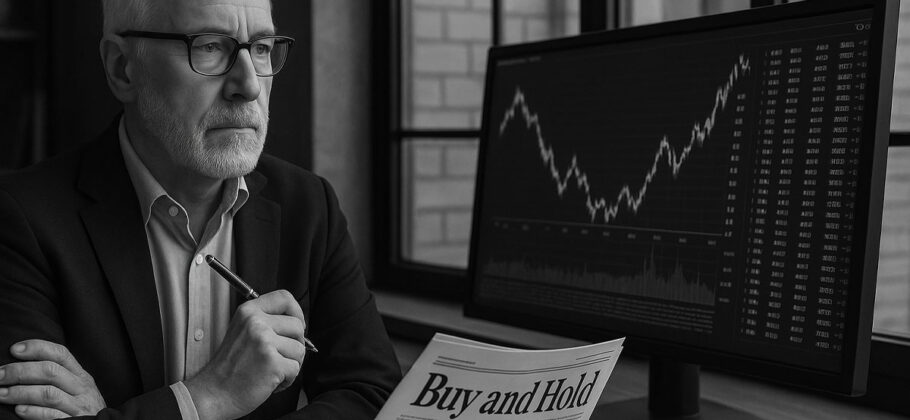With stock markets showing signs of weakness and volatility returning in force, the Wall Street Journal and other financial voices are urging investors to hold steady. Despite the recent dip in the S&P 500 and worries about rising tariffs, financial experts argue that now is a critical time to stick with your investment strategy and resist the urge to panic. Their message is simple: buy and hold, even when the market feels unpredictable.
The Market is Shaky, But Not Broken
The S&P 500 dropped 2.6% over the past week, marking its worst decline since early April. That earlier slump was triggered by President Trump’s announcement of wide-ranging tariffs, which shocked global markets and caught many investors off guard. The slide continued on Friday, with the index losing another 0.7% after Trump said he was considering new tariffs on European goods and even on iPhones that are manufactured overseas.
This kind of market turbulence is difficult for many individual investors to stomach. Some are looking for safety, moving money into money market accounts and certificates of deposit that now offer returns of 4% to 5%. Others, however, see an opportunity to buy discounted stocks while others are fleeing.
According to The Wall Street Journal, the roller coaster has become a true test of investor resolve. “Such is the gut-wrenching nature of being a buy-and-hold stock investor these days,” wrote WSJ reporters Hannah Erin Lang and Dalvin Brown. They noted that investors had enjoyed “steady gains and few prolonged slumps” over the past two years, but the recent trade-related upheaval is now challenging those expectations.
Buy-and-Hold Requires Patience—and Courage
Bill Jensen, a 68-year-old retiree, experienced the shock of watching a portion of his retirement portfolio vanish in early April. He admitted to having “some moments of regret” and said his wife considered pulling their money out of stocks. But Jensen decided to wait it out. “You have to take the good with the bad,” he said. Seven weeks later, most of their losses had been recovered.
Jensen is not alone. Financial advisors are spending more time than usual coaching their clients through the turmoil. Jon Ulin, managing principal at Ulin & Co. Wealth Management in Boca Raton, Florida, said it’s like running a support line. “It’s like a self-help line,” he said. He encourages clients not to make impulsive decisions, comparing sudden selling to “switching seats on an airplane that is going through turbulence.”
Not everyone is taking that advice. Myra Sletson, a retired banker in Pennsylvania, has moved 80% of her portfolio into safer assets like money markets and CDs. “This just isn’t the moment to be brave,” she said. While she remembers staying invested through the 2008 financial crisis, she explained, “I was younger then—in my 50s—with more time to recover.”
Yet, for those who stayed in, April’s quick rebound was a powerful example of why long-term investors are often rewarded. JPMorgan analysts reported that between April 8 and May 14, retail investors poured approximately $50 billion into equities, taking advantage of lower prices. Many were rewarded when major indexes bounced back.
Paul Spriggs, who has significant investments in college savings plans, didn’t make any changes during the downturn. He’s focused on the long term. “I’ve got enough of a timeline that I think I can recover,” he said. “I don’t come from money. I’m a middle-class kid. The only way to get ahead is to play the long game.”
What Motley Fool Says to Buy and Hold
The team at Motley Fool shares this long-term view. They recently identified three stocks they believe are worth holding over many years—Amazon, Domino’s Pizza, and Pool Corporation. These companies, while very different in nature, all offer steady performance and strong fundamentals.
Amazon, with its growing cloud business Amazon Web Services (AWS), is down 17% from its all-time high. But as Motley Fool writer Jon Quast explained, this kind of drop has only happened three other times in the past decade—and each time proved to be a buying opportunity. AWS alone brings in $117 billion in annual revenue and is expected to grow dramatically as more businesses move their technology infrastructure to the cloud. According to Amazon CEO Andy Jassy, “85% of enterprise spending on information technology still takes place on premises,” which leaves massive room for AWS to expand.
Domino’s Pizza is another stock Berkshire Hathaway recently increased its stake in. It’s not a high-growth tech company, but it’s reliable. Domino’s uses a franchise model that brings in strong profits with low overhead. With recent partnerships, such as one with DoorDash, and regular dividend increases, Domino’s has become a solid source of steady returns. “Consumers around the world love to eat pizza,” Quast noted, and that habit is unlikely to change.
Pool Corporation may seem like an odd pick, especially since pool installations are down. But Pool gets 60% of its revenue from people maintaining existing pools, not building new ones. Buffett’s firm doubled its stake in the company earlier this year. Despite sales falling 4% in the last quarter, Pool still returned $100 million to shareholders through buybacks and dividends.
Seeking Alpha’s Long Bet: Nu Holdings
Seeking Alpha suggests another long-term investment: Nu Holdings, also known as Nubank. As Latin America’s largest digital bank, Nubank now serves 118.6 million customers and continues to grow across Brazil, Mexico, and Colombia. Even though the company missed some earnings targets for the first quarter of 2025, its user base and revenue are still expanding rapidly.
Nu has also launched new services like NuPay and Nu Travel, and it’s moving into telecommunications with NuCel. These verticals are helping the company diversify away from its credit-heavy model. JPMorgan projects that Nu’s earnings could grow more than 30% annually over the next three years.
The biggest opportunity for Nubank lies in serving the unbanked. Around 35% of adults in Latin America do not have a bank account, and 42% do not own a credit card. With its low-cost, mobile-first platform, Nubank is well positioned to dominate this space if it can continue scaling its operations.
Yahoo Finance on TFI International: A Value Play
Over at Yahoo Finance, the spotlight is on a different type of opportunity—value investing in industrial stocks. Jitendra Parashar highlighted TFI International, a Canadian transportation and logistics company, as a “magnificent industrial giant” that is currently trading 45% below its 52-week high.
Despite a rough first quarter due to shrinking margins and soft freight volume, TFI still managed to post $1.96 billion in revenue and increased its free cash flow by 40%. The company returned $95 million to shareholders and made strategic acquisitions like Basin Transportation and Veilleux Transit. With strong fundamentals and a steady dividend, many analysts believe TFI is undervalued and could bounce back sharply.
When Will the Situation Change?
The uncertainty is likely to continue. Tariff threats, geopolitical instability, and economic shifts may all contribute to further volatility in the short term. However, the case for staying invested is built on the principle that markets recover more often than they collapse, and gains tend to come when they are least expected.
Research consistently shows that missing just a few of the market’s best days can drastically reduce long-term returns. And many of those best days happen during periods of overall gloom. As the Wall Street Journal explained, “It is a truism of long-term investing not to sell in the middle of market upheaval.”
In the face of economic stress and market losses, the advice from seasoned investors remains unchanged: stick to your plan, and think long-term. Whether it’s tech giants like Amazon, solid franchises like Domino’s, expanding fintechs like Nubank, or underpriced logistics firms like TFI, the opportunity for long-term growth remains—if you can stay the course.
FAM Editor: You should not consider this to be financial or investing advice, we don’t do that. Do your own damned research, make up your own damned mind.





